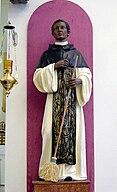Afro-Peruvian

Notable African Peruvians:
María Elena Moyano, St. Martin de Porres, Pancho Fierro, Nicomedes Santa Cruz, Susana Baca, Jefferson Farfan, Teófilo Cubillas, Guillermo Lobatón |
|
| Total population | |
|---|---|
| 616,283 (approx) | |
| Regions with significant populations | |
| Coastal cities | |
| Languages | |
| Spanish | |
| Religion | |
| Predominantly Roman Catholicism a minority of Protestantism, Animism, Other |
|
| Related ethnic groups | |
| African people, Afro-Brazilian People and Peruvian people |
Afro-Peruvians (also Afro Peruvians) are citizens of Peru descended from Africans who were enslaved and brought to the Western hemisphere with the arrival of the conquistadors towards the end of the slave trade.
The first Africans arrived with the conquistadors in 1521, mostly as slaves, and some returned with colonists to settle in 1525. Between 1529 and 1537, when Francisco Pizarro was granted permits to import 363 slaves to colonial Peru, a large group of Africans were imported to do labor for public construction, building bridges and road systems. They also fought alongside the conquistadors as soldiers and worked as personal servants and bodyguards. In 1533 Afro-Peruvian slaves accompanied Spaniards in the conquest of Cuzco.
Two types of black slaves were imported to Peru. Those who were native-born in Africa were commonly referred to as bozales ("unskilled", "untrained"), which was also used in a derogatory sense. These slaves could have been directly shipped from west or southwest Africa or transported from the Spanish Indies or other Spanish colonies. Afro-Peruvians previously acculturated to Spanish culture and who spoke Spanish were called Ladinos; some were mixed-race, descendants of Spanish men and African women. People of color performed skilled and unskilled functions that contributed to Hispanic colonization.
In urban areas Afro-Peruvians were cooks, laundresses, maids, handymen, and gardeners. In some cases, they worked in the navy, hospitals, churches and charitable institutions. In 1587, 377 people of African descent worked in the shipyards. The industry included a significant number of blacks working in quarries, kilns and construction projects. There were not enough Spanish workers to build the colony, so blacks essentially kept the economy running. Gradually, Afro-Peruvians were concentrated in specialized fields that drew upon their extensive knowledge and training in skilled artisan work and in agriculture.
In the social hierarchy of the slave stratum, the black artisans had the highest rank due to their skills. They worked as carpenters, tailors, blacksmiths, swordsmiths and silversmiths. This group enjoyed more freedom than their fellows who worked at large haciendas or in private households. Spanish small-business keepers would dispatch a whole team of servant-artisans to do a job independently and then return to their owner. As the prices for artisans rose, black artisans gained better treatment and sometimes took a role of a low-ranking employee. Skilled trades were a major avenue of social progress for the colored population. Due to their high skills, Afro-Peruvians gained prestige among Spanish noblemen. They occupied a relatively low social stratum but had some status related to the natives, and were considered above the emerging class of mestizos (descendants of indigenous people and Spanish colonists).
...
Wikipedia
